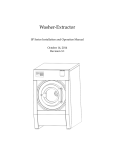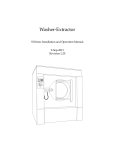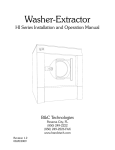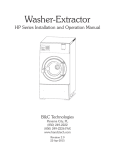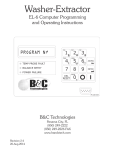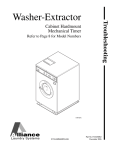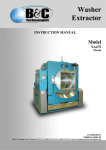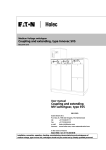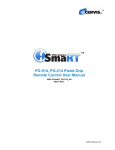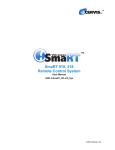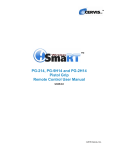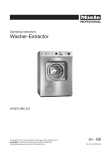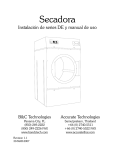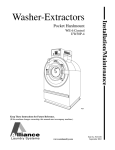Download HE Series - B&C Technologies
Transcript
Washer-Extractor HE Series Installation and Operation Manual November 4, 2014 Revision 2.91 Contents 1 2 Important Instructions 2 1.1 Before Attempting Repairs . . . . . . . . . . . . . . . . . . . . . . . . . . . . . . . . . . 2 1.2 Parts Ordering Information . . . . . . . . . . . . . . . . . . . . . . . . . . . . . . . . . 3 1.2.1 Nameplate Location . . . . . . . . . . . . . . . . . . . . . . . . . . . . . . . . . 3 1.3 Key Symbols . . . . . . . . . . . . . . . . . . . . . . . . . . . . . . . . . . . . . . . . . . 3 1.4 Safety Information . . . . . . . . . . . . . . . . . . . . . . . . . . . . . . . . . . . . . . 5 1.5 Installation and Operational Safety Instructions . . . . . . . . . . . . . . . . . . . . . 5 Introduction 6 2.1 Customer Service . . . . . . . . . . . . . . . . . . . . . . . . . . . . . . . . . . . . . . . 6 2.2 Replacement Parts . . . . . . . . . . . . . . . . . . . . . . . . . . . . . . . . . . . . . . 7 2.3 Theory of Operation . . . . . . . . . . . . . . . . . . . . . . . . . . . . . . . . . . . . . 7 3 General Specifications 9 4 Installation 11 4.1 Receiving Inspection . . . . . . . . . . . . . . . . . . . . . . . . . . . . . . . . . . . . . 11 4.2 Safety Checklist . . . . . . . . . . . . . . . . . . . . . . . . . . . . . . . . . . . . . . . . 11 4.2.1 Operator Safety . . . . . . . . . . . . . . . . . . . . . . . . . . . . . . . . . . . . 12 4.2.2 Safe Operation Environment . . . . . . . . . . . . . . . . . . . . . . . . . . . . 13 4.2.3 Environmental Conditions . . . . . . . . . . . . . . . . . . . . . . . . . . . . . 13 4.2.4 Machine Location . . . . . . . . . . . . . . . . . . . . . . . . . . . . . . . . . . . 14 4.2.5 Input and Output Services . . . . . . . . . . . . . . . . . . . . . . . . . . . . . . 14 4.2.6 Inverter Drive . . . . . . . . . . . . . . . . . . . . . . . . . . . . . . . . . . . . . 15 i 4.2.7 Machine Misuse . . . . . . . . . . . . . . . . . . . . . . . . . . . . . . . . . . . . 15 4.3 Dimensional Clearances . . . . . . . . . . . . . . . . . . . . . . . . . . . . . . . . . . . 16 4.4 Machine Foundation . . . . . . . . . . . . . . . . . . . . . . . . . . . . . . . . . . . . . 17 4.4.1 Machine Foundation Construction . . . . . . . . . . . . . . . . . . . . . . . . . 18 Mounting Bolt Installation . . . . . . . . . . . . . . . . . . . . . . . . . . . . . . . . . . 20 4.5.1 HE-35 Mounting Bolt Installation . . . . . . . . . . . . . . . . . . . . . . . . . . 20 4.5.2 HE-45 Mounting Bolt Installation . . . . . . . . . . . . . . . . . . . . . . . . . . 21 4.5.3 HE-65 Mounting Bolt Installation . . . . . . . . . . . . . . . . . . . . . . . . . . 22 4.5.4 HE-85 Mounting Bolt Installation . . . . . . . . . . . . . . . . . . . . . . . . . . 23 4.5.5 HE-110 Mounting Bolt Installation . . . . . . . . . . . . . . . . . . . . . . . . . 24 4.6 Drain Installation . . . . . . . . . . . . . . . . . . . . . . . . . . . . . . . . . . . . . . . 25 4.7 Electrical Installation . . . . . . . . . . . . . . . . . . . . . . . . . . . . . . . . . . . . . 26 4.8 Water Connection . . . . . . . . . . . . . . . . . . . . . . . . . . . . . . . . . . . . . . . 28 4.9 Steam Connection . . . . . . . . . . . . . . . . . . . . . . . . . . . . . . . . . . . . . . . 28 4.10 External Chemical Supplies . . . . . . . . . . . . . . . . . . . . . . . . . . . . . . . . . 29 4.10.1 Chemical Connection . . . . . . . . . . . . . . . . . . . . . . . . . . . . . . . . 30 4.10.2 Chemical Signal Connections . . . . . . . . . . . . . . . . . . . . . . . . . . . . 31 4.11 Control Function Test . . . . . . . . . . . . . . . . . . . . . . . . . . . . . . . . . . . . . 32 Operation 34 5.1 Door Lock Operation . . . . . . . . . . . . . . . . . . . . . . . . . . . . . . . . . . . . . 34 5.1.1 Opening and Closing the Door . . . . . . . . . . . . . . . . . . . . . . . . . . . 34 5.1.2 Periodic Maintenance . . . . . . . . . . . . . . . . . . . . . . . . . . . . . . . . 34 5.2 Machine Loading . . . . . . . . . . . . . . . . . . . . . . . . . . . . . . . . . . . . . . . 35 5.3 Wash Program Execution . . . . . . . . . . . . . . . . . . . . . . . . . . . . . . . . . . . 36 5.3.1 Cycle Selection . . . . . . . . . . . . . . . . . . . . . . . . . . . . . . . . . . . . 36 5.3.2 Cycle Execution . . . . . . . . . . . . . . . . . . . . . . . . . . . . . . . . . . . . 36 4.5 5 6 Maintenance 38 6.1 Daily . . . . . . . . . . . . . . . . . . . . . . . . . . . . . . . . . . . . . . . . . . . . . . 38 6.1.1 38 Beginning of Day . . . . . . . . . . . . . . . . . . . . . . . . . . . . . . . . . . . ii 6.1.2 7 8 End of Day . . . . . . . . . . . . . . . . . . . . . . . . . . . . . . . . . . . . . . 39 6.2 Weekly . . . . . . . . . . . . . . . . . . . . . . . . . . . . . . . . . . . . . . . . . . . . . 39 6.3 Monthly . . . . . . . . . . . . . . . . . . . . . . . . . . . . . . . . . . . . . . . . . . . . 39 6.4 Quarterly . . . . . . . . . . . . . . . . . . . . . . . . . . . . . . . . . . . . . . . . . . . . 41 6.5 Care of Stainless Steel . . . . . . . . . . . . . . . . . . . . . . . . . . . . . . . . . . . . . 42 Service & Parts 44 7.1 Service . . . . . . . . . . . . . . . . . . . . . . . . . . . . . . . . . . . . . . . . . . . . . 44 7.2 Parts . . . . . . . . . . . . . . . . . . . . . . . . . . . . . . . . . . . . . . . . . . . . . . 44 Decommisioning 45 iii Figure 1: HE Product Family 1 Chapter 1 Important Instructions 1.1 Before Attempting Repairs Moving parts can cause serious injury or death. Before attempting repairs, follow proper shutdown procedures and remove power before commencement of service. Safety is of primary concern with any maintenance or repair operation. If you are in any way unsure of how to proceed with a repair or adjustment, consult this manual, a qualified maintenance technician, your local distributor, or the B&C Technologies Technical Service Department at 850-249-2222. Only trained and experienced personnel should attempt maintenance or repair work on this equipment. Follow all safety procedures including lock-out/tag-out procedures carefully. Ensure that any loose fitting clothing or jewelry is tucked in or not worn to avoid being pulled into the machine. Remember, the machine has no brain - you must use your own. Before attempting repairs, follow proper shutdown procedures and remove power before commencement of service. Never attempt to clean or service any area of the machine without removing power at the main disconnect. Read, follow, and obey these safety rules! The B&C Technologies Technical Service Department 2 is available to answer any questions you may have about the operation and servicing of your machine. Please call with any questions or concerns about the operation of your machine. 1.2 Parts Ordering Information If you require literature or spare parts, please contact your local distributor. If a local distributor is unavailable, you may contact B&C Technologies directly at (850) 249-2222 for the name of your nearest parts dealer. For technical assistance in the United States, contact B&C Technologies: (850) 249-2222 Phone (850) 249-2226 FAX [email protected] www.bandctech.com 1.2.1 Nameplate Location When contacting B&C Technologies about your equipment, please make note of the model and serial number, located on the nameplate as shown in figure 1.1. Figure 1.1: Serial Decal 1.3 Key Symbols Anyone operating or servicing this machine must follow the safety rules in this manual. Particular attention must be paid to the DANGER, WARNING, and CAUTION blocks which appear throughout the manual and shown in figures 1.2 on page 4 and 1.3 on page 4. 3 Figure 1.2: Key Symbols Figure 1.3: Key Symbols 4 1.4 Safety Information Installation Notice: For personal safety and for proper operation, the machine must be grounded in accordance with state and local codes and in the USA in accordance with the National Electric Code, article 250-96. Elsewhere, the equipment should be grounded in accordance with ANSI/NFPA 70, or the Canadian Electrical Code, CSA C22.1. The ground connection must be to a proven earth ground, not to conduit or water pipes. 1.5 Installation and Operational Safety Instructions 1. Read all instructions prior to operating this equipment. 2. Ensure that the equipment is properly grounded before applying power and operation commences. 3. Do not allow children to play in or around or operate this equipment. 4. Check the operation of all safety interlocks at the start of every shift. If the interlocks do not stop the equipment immediately, the machine must be removed from service. Notify your immediate supervisor, and do not operate the machine. 5. Never attempt to service the machine while it is running. Never reach over, under, around, or behind any safety device, or into any area near moving parts or hot surfaces without shutting off power and allowing the machine to adequately cool. 6. Read, understand, and follow all safety instructions. Do not come close to moving parts and hot surfaces. Do not wear loose clothing, jewelry, neckties, or any other garment that could be come caught in the machine while operating or near the machine. 7. Only a qualified technician should attempt to service or repair the machine. 8. Do not install the machine in an area where it could be exposed to water or weather. 9. Do not alter or tamper with the control system. 10. Keep the interior and exterior of the machine clean of lint, dirt, dust and debris. 11. Always disconnect the electrical service from the machine before performing service. 12. This machine must be installed according to the installation instructions. All utility connections must comply with state and local codes and must be made by a licensed installer where required. 5 Chapter 2 Introduction The HE line is the professional fixed mount washer-extractor series of machines from B&C Technologies. It is an open pocket washer-extractor with a large door opening for easy and quick loading and unloading. It has been developed for the on premise market, and is suitable for commercial laundries, hotel and other places where laundry might be processed. The design allows for top performance at lowest possible operation cost and investment. The flexible electronic control center ensures that maximum productivity is obtained. The HE series utilizes high quality material, such as 304 (18/8) stainless steel in vital parts in contact with the wash solution. It has a stainless steel and painted cabinet for long life with easily removable panels. The key advantages of this series are the simplicity of the microprocessor and the electronic AC drive system, which utilizes only one motor. The system allows for washing, extraction and mechanical action to suit any textile fiber used today and tomorrow. The high speed final extraction saves time and energy in the finishing operation. A multi compartment supply dispenser for powder and liquid detergents is standard and the machine is designed to accept the connection of 4 external chemical lines and pumps. 2.1 Customer Service For technical assistance: In the United States Phone: (850)-249-2222 FAX: (850) 249-2226 e-mail: [email protected] Web: www.bandctech.com 6 2.2 Replacement Parts In the event that literature or replacement parts are required, contact the local distributor of the equipment, or contact B&C Technologies at the above phone numbers/internet addresses. 2.3 Theory of Operation The HE models use a single-speed motor to drive the cylinder via V-belts in all speeds. The cylinder is supported by two spherical roller bearings located in a bearing housing made of cast iron. The motor is controlled by the computer control located in the front and the AC inverter drive located in the rear panel. Wash and extract speeds are fixed. Any temperature between 70F to 200F (20-95C) can be programmed. The water level is fixed, with a low level and a high level provided (medium level is included with the A computer). The computers will automatically provide safety levels for steam injections and door operations. The AC Drive performs balance detection to ensure that excessively out of balance loads do not damage the machine or floor. A catastrophic failure sensor is also provided to stop the machine in the event of a severe malfunction. Water entry into the machine is through an air gap vacuum breaker utilizing electro-magnetic water valves controlled by the computer. By utilizing the air gap vacuum breaker, backflow into the water supply is impossible. The computer also controls the drain, supply dispenser, any external liquid supplies, steam injection and any other vital functions of the wash program. The steam, if installed, is injected in the bottom of the shell via a steam injector. The steam is controlled by a steam valve that is programmed by the micro computer. The cylinder is perforated, allowing water to pass through and drain from within during drain and extract steps. Lifting ribs inside the cylinder lift the load from the wash solution and allow the load to tumble and falling back into the solution when the load reaches the approximate 10-11 o’clock or 1-2 o’clock positions. This mechanical action removes soil from the fabric. Furthermore, the lifters are perforated on the top so that water can cascade over the goods and wet them quickly. This reduces water consumption as water is picked up at the cylinders lowest point and lifted and splashed over the goods at the highest point as the cylinder rotates. A stainless steel door is provided for loading and unloading. A door lock system prevents operation of the machine when the door is open. The door is locked during operation utilizing an electronic solenoid and a latch for safety reasons. The door lock is provided with magnetic sensor to indicate that the door is closed and locked and allows for start of the machine when the door is closed and locked. The AC drive, circuit overload protectors, input power supply connections, external supply connections, and control transformer are behind a cover on the rear of the machine. The supply dispenser is mounted on the front of the machine and is accessed by opening the cover door. Supplies, both liquid and powder, may be added by pulling the dispenser cups out and placing the appropriate supply in each. Supplies are flushed into the machine at the proper time in the cycle, controlled by the micro computer. 7 Holes are provided at the rear of the machine for connection to an external, central liquid supply unit. Electrical connections are provided for the liquid supply unit on a terminal strip inside the rear control module. Refer to page 32 for connection details. 8 Chapter 3 General Specifications Figure 3.1: HE Series General Specifications 9 Figure 3.2: HE Series Basic Dimensions 10 Chapter 4 Installation 4.1 Receiving Inspection Upon receipt of the equipment, visually inspect for shipping damage and note any damage with the carrier before signing the shipping receipt, or advise the carrier of the damage as soon as it is noted. If damage is discovered, a written claim must be filed with the carrier as soon as possible. Note: Warranty is VOID unless the equipment is installed according to instructions. The installation must comply with the minimum requirements listed in this manual. All national, state and local codes must be followed including but not limited to gas, electrical, plumbing and HVAC. Due to various requirements, statutory codes should be well understood before installation commences. Important: The machine should be transported and handled in an upright position. 4.2 Safety Checklist Before Initial start up of a B&C washer extractor perform the following safety check: 1. Make sure all electrical and plumbing connections have been made in accordance with applicable codes and regulations. 2. Make sure the machine is grounded electrically. 3. Make sure the machine has flexible water fill and drain connections of the correct size, length and type, with no kinks, and that they are securely attached and/or clamped. Before machine is placed in operation, the door safety interlock must be checked for proper operation as follows: 11 Before servicing any equipment, make certain it is disconnected from the electrical power source. Never allow operation of the machine when any safety device is malfunctioning. Never bypass safety devices. Never insert hands or objects into basket until it has completely stopped. Doing so could result in serious injury. 1. When the washer is energized electrically and in operation, the loading door must be locked in the closed position. Verify this by attempting to open the loading door when the machine is operating. If necessary, check the door safety interlock and sensors for proper operation. Consult the service manual, or call a qualified service technician if necessary. 2. When the washers loading door is open, it should not be possible to start the machine. Verify this by attempting to start the washer with the door open. Also, close the door without locking it and verify that it is not possible to start the machine with the door not locked. If necessary, check the door lock sensors for proper operation,. Consult the service manual, or call a qualified service technician. If additional information is required, contact your local distributor or call the manufacturer of the machine. • To provide personal safety and keep the machine in proper working order, follow all maintenance and safety procedures presented in this manual. If questions regarding safety arise. Contact the factory immediately. • Use factory authorized spare parts to avoid safety hazards. 4.2.1 Operator Safety To ensure the safety of machine operators the following maintenance checks must be performed daily. 1. Prior to operating the machine, verify that all warning signs are present and legible. Missing or illegible signs must be replaced immediately. Make certain that spares are available. 2. Check door interlock before starting operation of the machine, see safety check list. 3. Do not attempt to operate the machine if any of the following conditions are present: (a) The door does not remain securely locked during the entire cycle. (b) Excessively high water level is evident. (c) Machine is not connected to a properly grounded circuit. Do not bypass any safety devices in the machine. 12 Never operate the machine with a bypassed or disconnected out-of-balance switch. Operating the machine with severe out-of-balance loads could result in personal injury and serious equipment damage. Do not place volatile or flammable fluids in any machine. Do not clean the machine with volatile or flammable fluids such as acetone, lacquer thinners, enamel reducers, carbon tetrachloride, gasoline, benzene, naphtha, etc. Doing so could result in serious personal injury and/or damage to the machine. 4.2.2 Safe Operation Environment Safe operation requires an appropriate operating environment for both the operator and the machine. If questions regarding safety arise, contact the factory. 4.2.3 Environmental Conditions 1. Ambient temperature. Water in the machine will freeze at temperatures of 32F (0C) or below. Temperatures above 120 F (50C) will result in more frequent motor overheating and, in some cases, malfunction or premature damage to solid state devices that are used in the machines. Special cooling devices may be necessary. 2. Humidity. Relative humidity above 90% may cause the machines electronics or motors to malfunction or may trip the ground fault interrupter. Corrosion problems may occur on some metal components. If the relative humidity is below 30% belts and rubber hoses may eventually develop dry rot. This condition can result in hose leaks, which may cause hazards external to the machine in conjunction with adjacent electrical equipment. 3. Ventilation. The need for make-up air openings for such laundry room accessories as dryers , ironers, water heaters, etc. must be evaluated periodically. Louvers, screens, or other separating devices may reduce the available air opening significantly. 4. Radio Frequency Emissions. A filter is available for machines in installations where floor space is shared with equipment sensitive to radio frequency emissions. All machines that are shipped to CE countries are equipped with this filter and comply with the EMI regulations. 5. Elevation. If the machine is to be operated at elevations over 3280 feet (1000 meters) above sea level, pay special attention to water levels and electronic settings ( particularly temperature) or desired result may not be achieved. 6. Chemicals. Keep stainless steel surfaces free of chemical residues to avoid corrosion. 7. Water damage. Do not spray the machine with water. Short circuiting and serious damage may result. Repair immediately all seepage due to faulty gaskets, etc. 13 Replace all panels that are removed to perform service and maintenance procedures. Do not operate the machine with missing guards or with broken or missing parts. Do not bypass any safety devices. 4.2.4 Machine Location 1. Foundation. The concrete floor must be of sufficient strength and thickness to handle the floor loads generated by the machine at high extract speeds. 2. Service/ Maintenance Space. Provide sufficient space to allow comfortable performance of service procedures and routine maintenance. This is especially important in connection with machines equipped with AC inverter drives. Consult installation instructions for specific details. 4.2.5 Input and Output Services 1. Water pressure. Best performance will be realized if water is provided at a pressure of 30-85 psi (2.0-5.7 bar). Although the machine will function properly at lower pressure, increased fill time will occur. Water pressure higher than 120 psi (8.0 bar) may result in damage to machine plumbing. components failure(s) and personal injuries. 2. Optional Steam heating pressure. Best performance will be realized if steam pressure is provided at a pressure of 30-80 psi (2.0-5.4 bar). Steam pressure higher than 125 psi (8.5 bar) may result in damage to steam components and may cause personal injuries. For machines equipped with optional steam heat, install piping in accordance with approved commercial steam practices. Failure to install a steam filter may void the warranty. 3. Drainage System. Provide drain lines or troughs large enough to accommodate the total quantity of water that could be dumped if all machines on the site drained at the same time from the highest attainable level. If drain troughs are used, they should be covered to support light foot traffic. 4. Power. For personal safety and for proper operation, the machine must be grounded in accordance with state and local codes. The ground connection must be to a proven earth ground, not to conduits or water pipes. An easy-access disconnect switch should be provided. Ensure that a ground wire from a proven earth ground is connected to the ground lug in the electrical junction box on this machine. Without proper grounding personal injury from electrical shock could occur and machine malfunctions may be evident. Computer-controlled machines must have a proper ground to prevent computer malfunctions. 14 Always disconnect power and water supplies before a service technician performs any service procedure. Where applicable, steam and/or compressed air supplies should also be disconnected before service is performed. 4.2.6 Inverter Drive Machines equipped with AC drives require special attention with regard to the operating environment. 1. An especially dusty or linty environment will require more frequent cleaning of the AC drive cooling fan filter and of the AC drive itself. 2. Power line fluctuations from sources such as an uninterruptible power supplies (UPS) can adversely affect machines equipped with the AC drive. Proper suppression devices should be utilized on the incoming power to the machine to avoid problems. 3. A clean power supply free from voltage spikes and surges is absolutely essential for machines equipped with the AC drive. Nonlinear inconsistencies (peaks and valleys) in the power can cause the AC drive to generate nuisance errors. If voltage is above 230V for 200 V installations or above 460V for 400V installations, a buck/boost transformer is recommended. If voltage is above 240V or 480V, a buck/boost transformer is required unless the factory advises differently. 4. Sufficient space to perform service procedures and routine preventive maintenance is especially important for machines equipped with AC drives. 4.2.7 Machine Misuse Even though this machine is an atmospheric vessel, never use it for any purpose other than washing fabrics. 1. Never wash petroleum-soaked rags in the machine. This could result in an explosion. 2. Never wash machine parts or automotive parts in the machine. This could result in serious damage to the wash cylinder. 3. Never stone wash in the machine. It could wear the wash cylinder and serious damage might occur to the machine. 4. Never use the machine for dyeing nor with harsh chemicals that can cause corrosion and other health hazards. 5. Never allow children to play on or around this machine. Death or serious injury can result if children become trapped in the machine. Do not leave children unattended while the machine door is open. These cautions apply to animals as well. 15 4.3 Dimensional Clearances When installing the washer-extractor, it is important to allow adequate clearance on all sides of the machine. When multiple machines are installed, it is important to allow for the specified minimum clearances between machines. The following table shows recommended minimum clearances for the various freestanding models. Note: The dimensions are approximate and subject to normal manufacturing tolerances. If exact dimensions are required for construction purposes, request certified drawings from the factory. We reserve the right to make changes at any time without notice. Figure 4.1: Minimum Service Clearances 16 Ensure that the machine is installed on a level floor of sufficient strength and that the recommended clearances for inspection and maintenance are provided. Never allow the inspection and maintenance space to be blocked. 4.4 Machine Foundation A proper foundation is an absolute necessity when installing a fixed mount washer extractor. Do not neglect details when doing foundation work. These details will ensure a stable installation, reducing the possibility of excess vibration at high speeds. The machine must be anchored to a smooth level surface so that the entire base of the machine is supported and rests on the mounting surface. Note! Do not support the machine at only four points. A concrete base designed to elevate the washer-extractor to a more comfortable working height may be used. Use care when designing a base, as the forces generated during extract are extreme. The base must be adequately tied into existing floor. The factory can provide, at extra cost, elevated base frames designed to handle the extreme forces encountered during the extract phase of the cycle. Using other non-factory designs can cause undesirable operation, machine damage, and in extreme circumstances, injury or death. Damage caused by use of non-factory base frames is not covered under warranty. Do not attempt to install this machine on wooden flooring of any kind, above ground level, or over basements. Installation must be slab on grade or equal. Figure 4.2: Floor Load Data 17 Figure 4.3: Foundation Bolt Location Figure 4.4: Typical Grouting Pattern 4.4.1 Machine Foundation Construction Place the machine adjacent to the foundation. Do not attempt to move it by pushing on the sides. 18 Figure 4.5: Machine Foundation Detail 1. Remove the wood skid by unscrewing the carriage bolts holding it to the bottom frame of the machine. 2. Carefully place the machine over the anchor bolts. Raise and level it 1/2 inch above the floor on four points, using spacers that can be removed. 3. Fill the spaces between the machine base and floor with machinery grout. Grout completely under the frame members. Remove front panel and rear panel to gain access to all frame members. Force grout under the machine base until all voids are filled. 4. Remove the spacers carefully, allowing the machine to settle into the wet grout. 5. Attached the mounting bolt washers and lock nuts to the anchor bolts after the grout has hardened. Tighten the lock nuts by even increments-one after the other-until all are tightened evenly and the machine is fastened securely to the floor. The nuts should be tightened in a diagonal fashion, which will help ensure equal tension at all anchor points. Retighten after one week of operation and check quarterly thereafter. 19 4.5 4.5.1 Mounting Bolt Installation HE-35 Mounting Bolt Installation The HE-35 uses 1/2-13 x 8”’ bolts. Embed the bolts in 3500 psi reinforced concrete with a minimum of 6”’ thickness. The threaded end of the bolt should extend 2 inches from the surface of the floor. Use the outboard bolt holes for standard installation, the inboard bolt holes for side by side installations, or installations near a wall or other object that would prevent access to the outboard holes. Refer to figure 4.6 on page 20. Figure 4.6: HE-35 Mounting Detail 20 4.5.2 HE-45 Mounting Bolt Installation The HE-45 uses 1/2-13 x 8”’ bolts. Embed the bolts in 3500 psi reinforced concrete with a minimum of 6”’ thickness. The threaded end of the bolt should extend 2 inches from the surface of the floor. Use the outboard bolt holes for standard installation, the inboard bolt holes for side by side installations, or installations near a wall or other object that would prevent access to the outboard holes. Refer to figure 4.7 on page 21. Figure 4.7: HE-45 Mounting Detail 21 4.5.3 HE-65 Mounting Bolt Installation The HE-65 uses 1/2-13 x 8”’ bolts. Embed the bolts in 3500 psi reinforced concrete with a minimum of 6”’ thickness. The threaded end of the bolt should extend 2 inches from the surface of the floor. Use the outboard bolt holes for standard installation, the inboard bolt holes for side by side installations, or installations near a wall or other object that would prevent access to the outboard holes. Refer to figure 4.8 on page 22. Figure 4.8: HE-65 Mounting Detail 22 4.5.4 HE-85 Mounting Bolt Installation The HE-85 uses 5/8-11 x 8”’ bolts. Embed the bolts in 3500 psi reinforced concrete with a minimum of 9”’ thickness. The threaded end of the bolt should extend 2 inches from the surface of the floor. Use the outboard bolt holes for standard installation, the inboard bolt holes for side by side installations, or installations near a wall or other object that would prevent access to the outboard holes. Refer to figure 4.9 on page 23. Figure 4.9: HE-85 Mounting Detail 23 4.5.5 HE-110 Mounting Bolt Installation The HE-110 uses 5/8-11 x 8”’ bolts. Embed the bolts in 3500 psi reinforced concrete with a minimum of 9”’ thickness. The threaded end of the bolt should extend 2 inches from the surface of the floor. Use the outboard bolt holes for standard installation, the inboard bolt holes for side by side installations, or installations near a wall or other object that would prevent access to the outboard holes. Refer to figure 4.10 on page 24. Figure 4.10: HE-110 Mounting Detail 24 4.6 Drain Installation A drain system of adequate capacity is essential to the machine performance. Ideally the water should empty through a 4 inch vented pipe directly into a sump or floor drain. See figure 4.12 on 25. A flexible connection must be made to a vented drain system to prevent an airlock or siphon effect. If proper drain size is not available or practical, a surge tank is required. A surge tank in conjunction with a sump pump should be used when gravity drainage is not possible, such as in below-ground-level installations. Before any deviation from specified installation procedures is attempted, the customer or installer should contact the manufacturer. Increasing the drain hose length, installing elbows, or causing bends will decrease drain flow rate and increase drain time, impairing machine performance. If the drain arrangement is inadequate, the machine will not extract and will not discharge water properly. Figure 4.11: Drain System Information Figure 4.12: Drain Connection 25 This machine must be installed, adjusted, and serviced by a qualified electrical maintenance personnel familiar with the construction and operation of this type of machinery. They must also be familiar with the potential hazards involved. If this warning is not observed, personal injury or equipment damage resulting in voiding the warranty may result. If controlling the AC drive with a parameter unit, the machines computer and its safety features are bypassed. This could allow the basket to rotate at high speeds with the door open. When using a parameter unit to control the AC drive, a large sign should be placed on the front of the machine warning people of the imminent danger. 4.7 Electrical Installation The AC drive requires a clean power supply free from voltage spikes and surges. A voltage monitor should be used to check incoming power. The customers local power company may provide such a monitor. The AC drive provides for an internal circuit breaker. A separate circuit breaker governs the control circuit. If input voltage measures above 230V for a 200V class drive or above 460V for a 400V class drive, either ask the power company if their representative can lower the voltage or install a bucking transformer kit available from the manufacturer. Voltages above 250V and 490V require additional measures. Contact the distributor or the manufacturer for assistance. Note: For single phase operation, connect input power to R and S, leaving the T terminal open. Note: Do not use phase adders (roto-phase) on inverter driven equipment! Note: Wire sizes shown are for copper, THHN, 90 conductor per NEC article 310 (USA). The machine should be connected to an individual branch circuit not shared with lighting or other equipment. Because this is a vibrating machine, the use of SO cable or similar, with a twist-lock plug, to connect the machine to main power is recommended. A shielded liquid tight or approved flexible conduit with proper conductor of correct size installed in accordance with National Electric Code (USA) or other applicable codes is also acceptable. The connection must be made by a qualified electrician Never touch terminals or components of the AC drive unless power is disconnected and the ”‘CHARGE”’ indicator LED is off. The AC drive retains potential deadly voltage for some time after the power is disconnected. There are no userserviceable parts inside the AC drive. Tampering with the drive will void the warranty. 26 Dangerous voltage are present in the electrical control boxes and at the motor terminals. Only qualified personnel familiar with electrical test procedures, test equipment, and safety precautions should attempt adjustments and troubleshooting. Disconnect power from the machine before removing the control box cover, and before attempting any service procedures. Figure 4.13: Electrical Service Requirements using the wiring diagram provided with the machine. See the Electrical Connection data Chart for correct wire sizes. For personal safety and for proper operation, the machine must be grounded in accordance with state and local codes and in the USA in accordance with the National Electric Code, article 250-96. The ground connection must be to a proven earth ground, not to conduit or water pipes. Do not connect the ground to the neutral (N) leg at the terminal strip (if so equipped). If a DELTA supply system is used, the high leg should be connected to T, since control voltage is derived from R and S. Insure that the control transformer taps are connected in accordance with the incoming line voltage. Verify connections as shown on the schematic with each machine. Figure 4.14: Electrical Service Connection Detail 27 4.8 Water Connection Individual hot and cold plumbing lines with individual shut-off valves must be available to the machine. Hot water should be minimum of 160F (70C). If lower temperature water is used the machine can be equipped for steam heating to heat the wash solution to desired temperature. Best performance will be realized if water is provided at a pressure of 30-85 psi (2-7 Bar). Although the machine will function properly at lower pressures, increased fill times will occur. Flush the water system for at least two minutes prior to initial use. Use flexible hoses and install separate screen filters in the lines to keep rust and other foreign particles out of the solenoid valves. Hang the hoses in a large loop. Do not allow the hoses to kink. The water connections to the machine should be supplied by a hot and cold water line of least the sizes shown in table 4.15 on page 28. Figure 4.15: Water Connection Detail To avoid eventual water hammer in the water line, suitable devices to reduce the water hammer should be installed. 4.9 Steam Connection For machines equipped with optional steam heat, install piping in accordance with approved commercial steam practices. Steam requirements are shown in the figure 4.16 on page 29. Failure to Never touch internal or external steam pipes, connections, or components. These surfaces can be extremely hot and will cause severe burns. The steam must be turned off and the pipe, connections, and components allowed to cool before the pipe can be touched. 28 install a steam filter/trap may void the warranty. Figure 4.16: Steam Service Connection Detail 4.10 External Chemical Supplies The following procedures must be observed when connecting any chemical injector to the washerextractor. See figure 4.17 on 30 for a typical supply injection system setup. Undiluted chemicals dripping can damage the machine. Therefore, all chemical supply dispenser pumps should be mounted below the washers injection point. All dispenser tubing should also run below the injection point. Loops do not prevent drips if these instructions are not followed. Failure to follow these instructions could damage the machine and void the warranty. Wear Eye and hand protection when handling chemicals. Always avoid direct contact with raw chemicals. Read the manufacturers directions for accidental contact before handling chemicals. Ensure that an eye-rinse facility and an emergency shower are within easy reach. Check at regular intervals for chemical leaks. 29 Figure 4.17: External Chemical Supply Connection Detail 4.10.1 Chemical Connection The supply compartment on the B&C HE models is located on the front of the machine. Supply cups can be accessed by opening the dispenser lid. The supply cups can be removed and filled as desired. Supply compartments are numbered 1,2,3, and 4 from the left of the machine to the right. Each cup supply will flush when Detergent is programmed in the control. The programmed chemical signal also appears as a 24VAC signal at the external chemical terminal strip for the duration of each programmed signal. External supply connections for the B&C HE washer-extractors with the Stainless Steel supply box are located on rear of the machine at the vacuum breaker. Hose connections should be made via the threaded connectors. See figure 4.18 on page 31. 1. Remove plugs from base. See figure. 2. Install the supplied chemical nipple, using teflon tape. 3. Insert tubes onto the nipples, using small hose clamps or wire ties to prevent the hose from slipping off. For the poly supply box, you must drill the nipples prior to use (max 1/4 bit). A 1/2 NPT connection is also provided for flushing systems. See figure 4.19 on page 31. 30 Figure 4.18: Stainless Steel Vacuum Breaker / Supply Box Figure 4.19: Poly Vacuum Breaker / Supply Box 4.10.2 Chemical Signal Connections Connection terminals are located in the rear control box for output signals to the chemicals injection supply pump. Refer to figure 4.20 on page 32. Terminals SUPPLY 1 through SUPPLY 4 provide signals for external chemical supply pumps. The signal is a maximum of 1/2 amp at 24V 50/60Hz. 31 Attempting to obtain power from the machine terminals may damage the machine circuit and/or the chemical injection system. Consult the chemical injection supply system instructions for operational details. Do not attempt to increase fuse rating as this will cause damage to the washer-extractor circuitry and void the warranty. Any injection system pump, which requires 24-220V AC must be powered by a separate external power source. Figure 4.20: External Chemical Supply Terminal Block Detail 4.11 Control Function Test The machine should be cleaned after the installation is complete. A function test should then be executed on the unloaded machine as follows: 1. Check the proper supply for such characteristics as correct voltage, phase, and cycles to be certain they are correct for the machine. 2. Open manual shut-off water valves to the machine. 3. Press Emergency Stop button. 4. Apply power to the machine. 5. Release the Emergency button. 6. Check the door interlock before starting the machine. (a) Attempt to start the machine with the door open. The machine should not start with the door open. 32 (b) Close the door without locking it and attempt to start the machine. The washer should not start with the door unlocked. (c) Close and lock the door and start a cycle. Attempt to open the door while the cycle is in progress. The door should not open. If the door lock and interlock are not functioning properly, call a service technician. 7. For testing, select the check cycle by pressing the down arrow on the keypad. Then press the START key. Run the complete program, checking operation of water inlet valves, drain, and extract functions. Refer to the A or B Computer Program manual that came with the machine for further details on the test program. 8. Cylinder rotation must be counter-clockwise in the extract step. If rotation is not correct, disconnect the power to the machine. A qualified technician must reverse any two leads between the AC drive and the motor. See figure 4.21 on page 33. Figure 4.21: Inverter Drive to Motor Detail 33 Chapter 5 Operation 5.1 Door Lock Operation The lock system uses a ”‘push-to-open / push-to-close”’ style mechanism which differentiates it from any other door lock in the industry. This design was developed as a result of analyzing the shortcomings of other door lock mechanisms on the market. It hence has many fundamental safety and mechanical advantages. 5.1.1 Opening and Closing the Door To open the door the machine must not be running a wash program – ”‘CY01”’ or the last program executed should be displayed on the control. Simply push and release the door handle with the palm of your hand. As you push the handle in the door lock solenoid will energize and the pin will retract and release the door. Then as you release the pressure on the handle the door will be free and you can pull it open. To close the door swing it closed, then push the handle firmly until you hear the solenoid engage, releasing the door lock pin to lock the door. When you start a wash program the door lock is securely disabled so that the door cannot be accidentally opened. 5.1.2 Periodic Maintenance • The door should be tested every day for safe operation by trying to start a program with the door open. If the machine will begin operation in this state it should immediately be removed from service, locked out, and a qualified service technician called to repair it. • If the door lock is malfunctioning in any way, the machine should immediately be removed from service, locked out, and a qualified service technician called to repair it. • The door lock pin and handle hinge should be lubricated with ”‘silicon spray lube”’ monthly. This product is available at almost any auto parts store. This procedure does not require any disassembly. 34 • The door handle nose bushing should be checked for wear and cracking monthly. It should be replaced when it is cracked, missing, or worn out. • The door lock tongue and lock pin alignment should be checked monthly and adjusted as needed. • For detailed instructions on door alignment, request TSB009 when contacting technical service. 5.2 Machine Loading Proper loading of your HE series washer-extractor is a great factor in determining both the performance and longevity of your investment. Small loads are wasteful on many levels: 1. Small loads waste water, chemicals, electricity, and most expensively, time. Running your machine at lower than its rated capacity costs you time and money. 2. Small loads cause more wear and tear on the machine. Small loads are very difficult to balance properly, and will cause excessive vibration during extract. These vibrations mean that bearing loads are higher, reducing the life of the main bearings. The extra vibrations also tend to cause other fasteners on the machine to loosen over time, causing premature wearing and more frequent service. 3. Smaller loads are not easier for the machine to handle - quite the opposite, they are more difficult on the entire machine. When the machine is under loaded, it causes greater stress on the inverter drive, belts, and motor, leading to reduced life of these expensive components. Refer to figure 5.1 on page 35 for proper loading weights. Figure 5.1: Proper Load Sizing If a scale isnt available, fill the machine up with goods to be laundered. Do not attempt to ”‘stuff”’ the machine full, but ensure that there is no gap at the top of the cylinder. 35 5.3 5.3.1 Wash Program Execution Cycle Selection Press the up or down key until the desired cycle number is showing on the display. Press the keys just hard enough to activate them. Pressing harder will cause undue wear on the keypad. After you arrive at the desired cycle, ensure the goods are loaded, and the door is closed. Then press Start. If the door is not properly closed and locked, the display will read Door until the door is properly closed and locked. After the door is closed, press start. 5.3.2 Cycle Execution A cycle can be aborted at any time by pressing the stop key. The machine will enter the stop routine after which the door may be unlocked (display reads done). To display the temperature of the wash solution during a cycle, press the up key. To display the cycle number currently in process, press the start key. For more detailed instructions and programming, see the programming manual supplied with your machine. A list of factory provided wash programs is also contained within the A or B Computer Programming Manual. 36 Figure 5.2: HE Series Computer Keypad 37 Chapter 6 Maintenance Routine maintenance maximizes operating efficiency and minimizes downtime. The maintenance procedures described below will prolong the life of the machine and help prevent accidents. Daily, weekly, monthly, and quarterly checklist are provided at the end of this section. Laminate the checklists to preserve them for repeated copying. Operators and technicians are encouraged to add checks specific to their machines particular application. When possible, space is provided on the checklists for this purpose. The following maintenance procedures must be performed regularly at the required intervals. 6.1 6.1.1 Daily Beginning of Day 1. Inspect water inlet valve hose connections on the back of the machine for leaks. 2. Inspect steam hose connections for leaks, where applicable. 3. Verify that insulation is intact on all external wires and that all connections are secured. If bare wire is evident, call a service technician. 4. Check door interlock before starting operation: (a) Attempt to start the washer with the door open. The washer should not start with the door open. Replace all panels that are removed to perform service and maintenance procedures. Do not operate the machine with missing guards or with broken or missing parts. Do not bypass any safety devices. 38 (b) Close the door without locking it and attempt to start the machine. The machine should not start with the door open. (c) Close and lock the door and start a cycle. Attempt to open the door while the cycle is in progress. The door should not open. If manual latch is moved out of position the machine should stop. If the door lock and interlock are not functioning properly, call a service technician. 6.1.2 End of Day 1. Clean the door gasket of residual detergent and foreign matters. 2. Clean the automatic supply dispenser and the lid inside and out with mild detergent. Rinse with clean water. 3. Clean the washers top, front and side panels with mild detergent. Rinse with clean water. 4. Leave loading door open at the end of each day to allow moisture to evaporate. NOTE: Leave loading door open at end of each complete cycle to allow moisture to evaporate. Unload the machine promptly after each completed cycle to prevent moisture build up. 6.2 Weekly 1. Check the machine for leaks. (a) Start an unloaded cycle to fill the machine. (b) Verify that door and door gasket do not leak. (c) Verify that the drain valve is operating. If water does not leak out during the prewash segment, drain valve is closed and functioning properly. 2. Clean the AC drive box air filters. (a) Snap off the external plastic cover which contains the filter. Remove the foam filter from the cover. (b) Wash the filter in a mild soap solution or vacuum it clean. Replace if damaged. Operating the machine without filter will cause premature inverter failure. 6.3 Monthly NOTE: Disconnect power to the machine at its source before performing the monthly maintenance procedures. 39 1. HE-65 (some models), HE-85, HE-110: Each month or after every 200 hours of operation, lubricate bearing and seals. See instructions on the machine. (a) Use a premium grade lithium complex grease. Never mix two types of grease. (b) Pump the grease gun slowly, permitting only the following number of strokes: (a) Bearing grease fitting, 2 strokes (b) Seal grease fitting, 1 stroke. Do not pump the grease gun if grease comes out of the bearing housing. This can result in over lubrication, causing damage to bearings and seals. 2. If the machine is provided with automatic lubricators, check that they are injecting grease. Normally they last for approximately one year (see TSB016 for details). Mark new lubricators with installation date. 3. Clean the AC drive fins: (a) Remove the AC drive box cover. (b) Blow the fins clean using compressed air at a pressure of 60- 90 psi ( 4-6 Bar) or by using canned compressed air. Use care to avoid damaging cooling fan or other components. NOTE: No amount of visible foreign matter should be allowed to accumulate on fins, finger guard, cooling fan or fan filter. Replace damaged fan filters. 4. Use the following procedures to determine if V-belts require replacement or adjustment. Call a qualified service technician in either case. (a) Check V-belts for uneven wear and frayed edges. (b) HE-35, HE-45, HE-65: After disconnecting power to the machine and removing all panels necessary for access to the drive belts, inspect motor tensioning spring and belt tension. (c) HE-85, HE-110: After disconnecting power to the machine and removing all panels necessary for access to the drive belts, use the following method to verify that the Vbelts are properly tensioned. Belt tensioning is straightforward, and accomplished by loosening the tension adjusting bolts and adjusting the belts to the proper tension. Then the bolts should be tightened. See figure 6.2. (d) Verify that V-belts are properly aligned by checking pulley alignment. Place a straightedge across both pulley faces. The straight edge should make contact with the pulleys in four places. See figure 6.1. 40 Figure 6.1: Proper Pulley Alignment Figure 6.2: Belt Tensioning Bolt Figure 6.3: Belt Tensioning Table 6.4 Quarterly NOTE: Disconnect power to the machine before performing the quarterly maintenance procedures. 1. Tighten door hinges and fasteners, if necessary. 2. Tighten anchor bolts, if necessary. 41 3. Check all painted surfaces for bare metal (matching paint is available from the manufacturer.) (a) If bare metal is showing, paint with primer or solvent-based paint. (b) If rust appears, remove it with sand paper or chemical means. Then paint with primer or solvent-based paint. 4. Clean steam filter, where applicable. See figure 6.4. 5. Remove back panel and check overflow hose and drain hose for leaks. 6. Remove top cover and check the supply dispenser hoses and hose connections. 7. Clean inlet hose filter screen: (a) Turn water off and allow valve to cool, if necessary. (b) Unscrew inlet hose and remove filter screen. (c) Clean with compressed air and reinstall. Replace if worn or damage. 8. Tighten motor mounting bolts and bearing housing bolts, if necessary. 9. Use compressed air to clean lint from motor. 10. Clean external water and steam filters Figure 6.4: Steam Trap Service 6.5 Care of Stainless Steel Maintain the natural beauty of stainless steel and prolong its service life by following these steps. 42 1. Ordinary deposits if dirt and grease can be removed with detergent and water. The metal should be thoroughly rinsed and dried after washing. Periodic cleaning will help to maintain the bright surface appearance and prevent corrosion. 2. Contact with dissimilar metal should be avoided whenever possible. This will help prevent galvanic corrosion when salty or acidic solutions are present. 3. Salty or acidic solutions should not be allowed to evaporate and dry on stainless steel. They may cause corrosion. Ensure that the stainless steel is wiped clean of acidic solution residues. 4. Deposits that adhere to the stainless steel should be removed, especially from crevices and corners. When using abrasive cleaners, always rub in the direction of the polish lines or grain of the stainless steel to avoid scratch marks. Never use ordinary steel wool or steel brushes on the stainless steel. Use stainless steel wool or soft non-metal bristle brushes.. 5. If the stainless steel appears to be rusting the source of the rust may actually be an iron or steel part not made of stainless steel, such as a nail or screw. One remedy is to paint all carbon steel parts with a heavy protective coating. Stainless steel fasteners should be used when possible. 6. Discolorations or heat tint from overheating may be removed by scouring with powder or by employing special chemical solutions. 7. Sanitizers or sterilizing solutions should not be left in stainless steel equipment for prolonged periods of time. They often contain chlorine, which may cause corrosion. The stainless steel should be cleaned and rinsed thoroughly of any solution containing chlorine. 8. When an external chemical supply system is used, make certain that no siphoning of chemicals occurs when the washer-extractor is not in use. Highly concentrated chemicals can cause severe damage to stainless steel and other components within the machine. Damage of this kind is not covered by the manufacturers warranty. Locate the pump below the washers injection point to prevent siphoning of chemicals into the machine. 43 Chapter 7 Service & Parts 7.1 Service Service must be performed by a qualified trained technician, service agency, or gas supplier. If service is required, contact the distributor from whom the equipment was purchased. If the distributor cannot be contacted or is unknown, contact B&C Technologies for a distributor in your area. For technical assistance in the United States, contact B&C Technologies: (850) 249-2222 Phone (850) 249-2226 FAX [email protected] www.bandctech.com NOTE: When contacting B&C Technologies be sure to supply the correct model number and serial number so that your inquiry is handled in an expeditious manner. 7.2 Parts Replacement parts should be purchased from the distributor from whom the equipment was purchased. If the distributor cannot be contacted or is unknown, contact B&C Technologies for a distributor in your area. Parts may also be purchased directly from the factory NOTE: When ordering replacement parts from a dealer or B&C Technologies, be sure to supply the correct model number and serial number so that your parts order can be processed in an expeditious manner. 44 Chapter 8 Decommisioning In the event that the machine must be decommissioned, follow these steps: 1. Clean interior of machine, both basket and shell. 2. Disconnect electrical power. (a) Shut of main power supply at the breaker box or main control panel. (b) Do not attempt to disconnect power supply wires from power supply. Have a qualified electrician disconnect power to machine at its source. 3. Disconnect gas/steam supply. 4. Disconnect exhaust system. 5. Remove the machine from its foundation pad. (a) Keep all panels in place to provide stability when moving the machine. (b) Verify that door is closed and secure (c) Place the machine on skid and bolt the frame to the skid. This will facilitate the removal of the machine on to a truck. 6. Recycle. The manufacturer uses the highest quality material in their products so that those material may be recycled at the end of the product’s service life. 45

















































